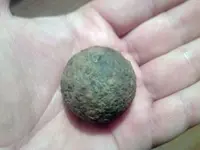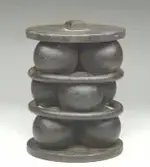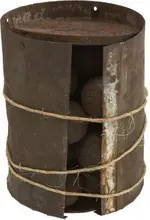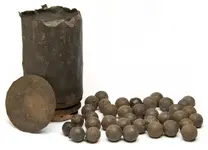Here are some charts to help. You should measure the diameter.
[TABLE="width: 550"]
[TR]
[TD="width: 100%, colspan: 3"]
Descriptions of solid iron balls used in stands of grape
[/TD]
[/TR]
[TR]
[TD="width: 26%, bgcolor: #F0F0F0"]
Caliber designation[/TD]
[TD="width: 44%, bgcolor: #F0F0F0"]
Allowable diameters in inches[/TD]
[TD="width: 30%, bgcolor: #F0F0F0"]
Mean weight in pounds[/TD]
[/TR]
[TR]
[TD="width: 26%"]12-Pdr.[/TD]
[TD="width: 44%"]2.02-2.06[/TD]
[TD="width: 30%"]1.14[/TD]
[/TR]
[TR]
[TD="width: 26%"]18-Pdr.[/TD]
[TD="width: 44%"]2.36-2.40[/TD]
[TD="width: 30%"]1.8[/TD]
[/TR]
[TR]
[TD="width: 26%"]24-Pdr.[/TD]
[TD="width: 44%"]2.60-2.64[/TD]
[TD="width: 30%"]2.4[/TD]
[/TR]
[TR]
[TD="width: 26%"]32-Pdr.[/TD]
[TD="width: 44%"]2.86-2.90[/TD]
[TD="width: 30%"]3.15[/TD]
[/TR]
[TR]
[TD="width: 26%"]42-Pdr.[/TD]
[TD="width: 44%"]3.13-3.17[/TD]
[TD="width: 30%"]4.2[/TD]
[/TR]
[TR]
[TD="width: 26%"]8-inch[/TD]
[TD="width: 44%"]3.54-3.60[/TD]
[TD="width: 30%"]6.1[/TD]
[/TR]
[/TABLE]
[TABLE="width: 550"]
[TR]
[TD="width: 99%, colspan: 3"]
Descriptions of solid iron balls used in canister
[/TD]
[/TR]
[TR]
[TD="width: 43%, bgcolor: #F0F0F0"]
Caliber designation[/TD]
[TD="width: 34%, bgcolor: #F0F0F0"]
Allowable diameters in inches[/TD]
[TD="width: 22%, bgcolor: #F0F0F0"]
Mean weight in pounds[/TD]
[/TR]
[TR]
[TD="width: 43%"]6-Pdr. Gun[/TD]
[TD="width: 34%"]1.14-1.17[/TD]
[TD="width: 22%"].21[/TD]
[/TR]
[TR]
[TD="width: 43%"]12-Pdr. Mountain Howitzer[/TD]
[TD="width: 34%"].69 lead musket balls[/TD]
[TD="width: 22%"][/TD]
[/TR]
[TR]
[TD="width: 43%"]12-Pdr. Field Howitzer[/TD]
[TD="width: 34%"]1.05-1.08[/TD]
[TD="width: 22%"].16[/TD]
[/TR]
[TR]
[TD="width: 43%"]12-Pdr. Gun[/TD]
[TD="width: 34%"]1.46-1.49[/TD]
[TD="width: 22%"].43[/TD]
[/TR]
[TR]
[TD="width: 43%"]18-Pdr. Gun[/TD]
[TD="width: 34%"]1.67-1.70[/TD]
[TD="width: 22%"].64[/TD]
[/TR]
[TR]
[TD="width: 43%"]24-Pdr. Gun[/TD]
[TD="width: 34%"]1.84-1.87[/TD]
[TD="width: 22%"].86[/TD]
[/TR]
[TR]
[TD="width: 43%"]24-Pdr. Howitzer[/TD]
[TD="width: 34%"]1.32-1.35[/TD]
[TD="width: 22%"].32[/TD]
[/TR]
[TR]
[TD="width: 43%"]32-Pdr. Gun[/TD]
[TD="width: 34%"]2.02-2.06[/TD]
[TD="width: 22%"]1.14[/TD]
[/TR]
[TR]
[TD="width: 43%"]32-Pdr. Howitzer[/TD]
[TD="width: 34%"]1.46-1.49[/TD]
[TD="width: 22%"].43[/TD]
[/TR]
[TR]
[TD="width: 43%"]42-Pdr. Gun[/TD]
[TD="width: 34%"]2.22-2.26[/TD]
[TD="width: 22%"]1.5[/TD]
[/TR]
[TR]
[TD="width: 43%"]8-inch Siege Howitzer[/TD]
[TD="width: 34%"]1.84-1.87[/TD]
[TD="width: 22%"].86[/TD]
[/TR]
[/TABLE]








